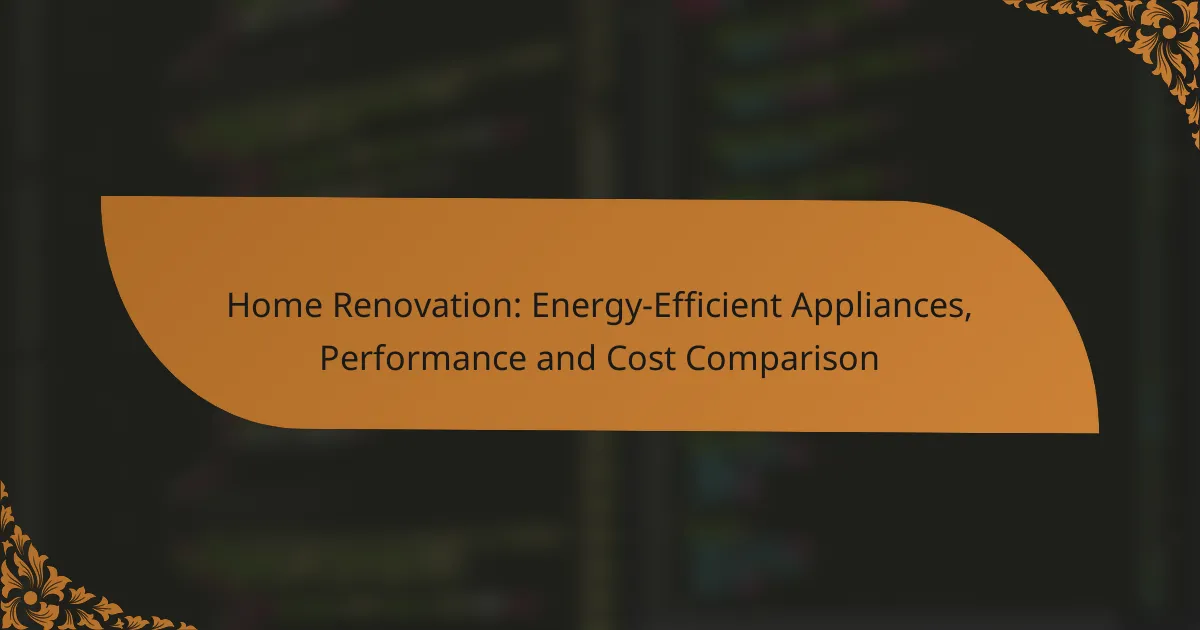Incorporating energy-efficient appliances into your home renovation can lead to substantial savings and a reduced environmental impact. These appliances, such as Energy Star certified refrigerators and high-efficiency washing machines, are designed to optimize performance while minimizing energy consumption. Although they may require a higher initial investment, the long-term utility savings and potential incentives make them a smart choice for homeowners looking to enhance both efficiency and functionality.

What are the best energy-efficient appliances for home renovation?
The best energy-efficient appliances for home renovation include those that significantly reduce energy consumption while maintaining performance. Key options are Energy Star certified refrigerators, high-efficiency washing machines, smart thermostats, LED lighting solutions, and induction cooktops.
Energy Star certified refrigerators
Energy Star certified refrigerators are designed to use less energy than standard models, often consuming 15-20% less. When selecting one, look for features like adjustable shelving and efficient cooling systems that enhance performance without sacrificing space.
Consider the size and layout of your kitchen, as larger units may offer more energy savings but require more upfront investment. Check for rebates or incentives in your area, which can offset costs and encourage energy-efficient choices.
High-efficiency washing machines
High-efficiency washing machines use advanced technology to reduce water and energy usage, often cutting consumption by 30-50% compared to traditional models. Look for front-loading machines, which typically use less water and have faster spin cycles, reducing drying time.
When choosing a model, consider the load capacity and cycle options to match your household needs. Many states offer rebates for purchasing energy-efficient appliances, so check local programs to maximize savings.
Smart thermostats
Smart thermostats optimize heating and cooling by learning your schedule and preferences, potentially reducing energy bills by 10-15%. They can be controlled remotely via smartphone apps, allowing for adjustments based on real-time conditions.
When selecting a smart thermostat, ensure compatibility with your HVAC system and consider features like geofencing and energy usage reports. Many utility companies provide incentives for installing these devices, making them a cost-effective choice.
LED lighting solutions
LED lighting solutions are highly energy-efficient, using up to 75% less energy than traditional incandescent bulbs. They also have a longer lifespan, reducing replacement costs and waste over time.
When renovating, replace all lighting fixtures with LED options, including recessed lighting and outdoor fixtures. Look for bulbs with the Energy Star label to ensure quality and efficiency, and consider dimmable options for added flexibility.
Induction cooktops
Induction cooktops use electromagnetic energy to heat pots and pans directly, resulting in faster cooking times and less wasted energy. They are generally 10-20% more efficient than gas or electric coil cooktops.
When choosing an induction cooktop, ensure your cookware is compatible, as it must be ferrous to work effectively. Consider the layout of your kitchen and the number of burners needed to suit your cooking habits, as these factors can influence overall efficiency and convenience.
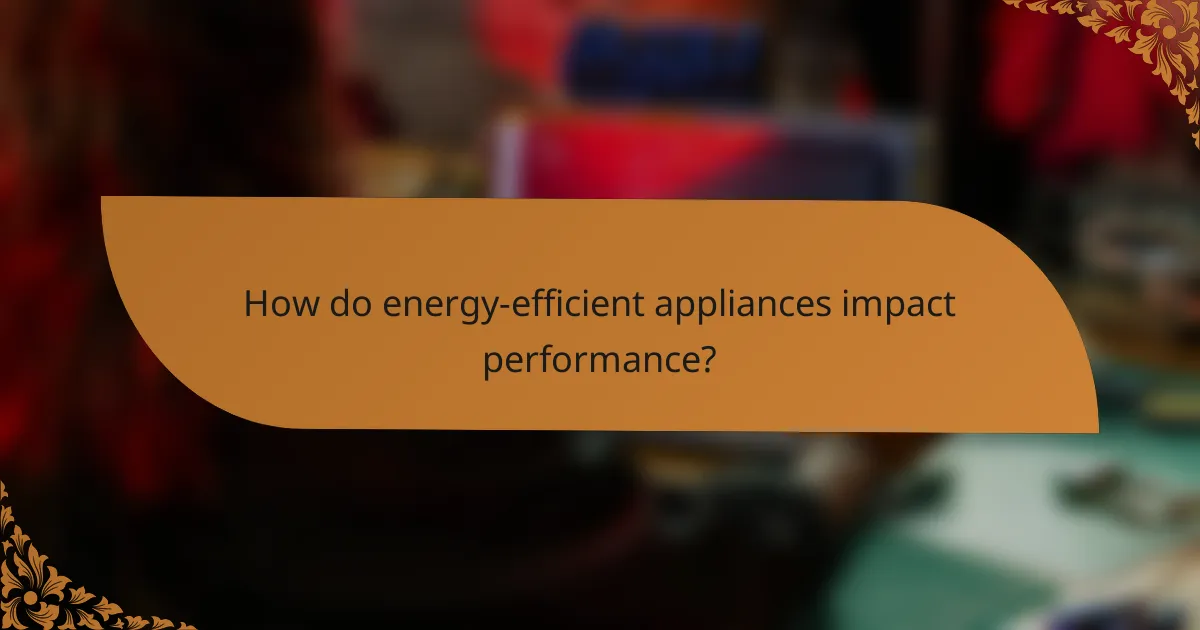
How do energy-efficient appliances impact performance?
Energy-efficient appliances significantly enhance performance by reducing energy consumption while maintaining or improving functionality. They are designed to use less electricity or water, which can lead to lower utility bills and a smaller environmental footprint.
Improved energy savings
Energy-efficient appliances are built to minimize energy usage, often achieving savings of 10-50% compared to standard models. For example, an Energy Star-rated refrigerator can save around 100 USD annually in electricity costs, depending on usage and local rates.
When selecting appliances, look for the Energy Star label or similar certifications, which indicate compliance with energy efficiency standards. This not only helps in saving money but also contributes to a more sustainable lifestyle.
Enhanced home comfort
Using energy-efficient appliances can lead to improved home comfort by maintaining consistent temperatures and humidity levels. For instance, energy-efficient air conditioners and heaters operate more effectively, ensuring a stable indoor climate without excessive energy use.
Additionally, these appliances often operate more quietly than their less efficient counterparts, reducing noise pollution in your home. This can enhance the overall living experience, making your home a more pleasant environment.
Longer lifespan of appliances
Energy-efficient appliances typically have a longer lifespan due to their advanced technology and design. By using less energy and operating more effectively, these appliances experience less wear and tear, which can extend their operational life by several years.
Investing in energy-efficient models may have a higher upfront cost, but the savings on energy bills and the reduced need for replacements can make them more economical in the long run. Regular maintenance and proper usage further contribute to maximizing their lifespan.
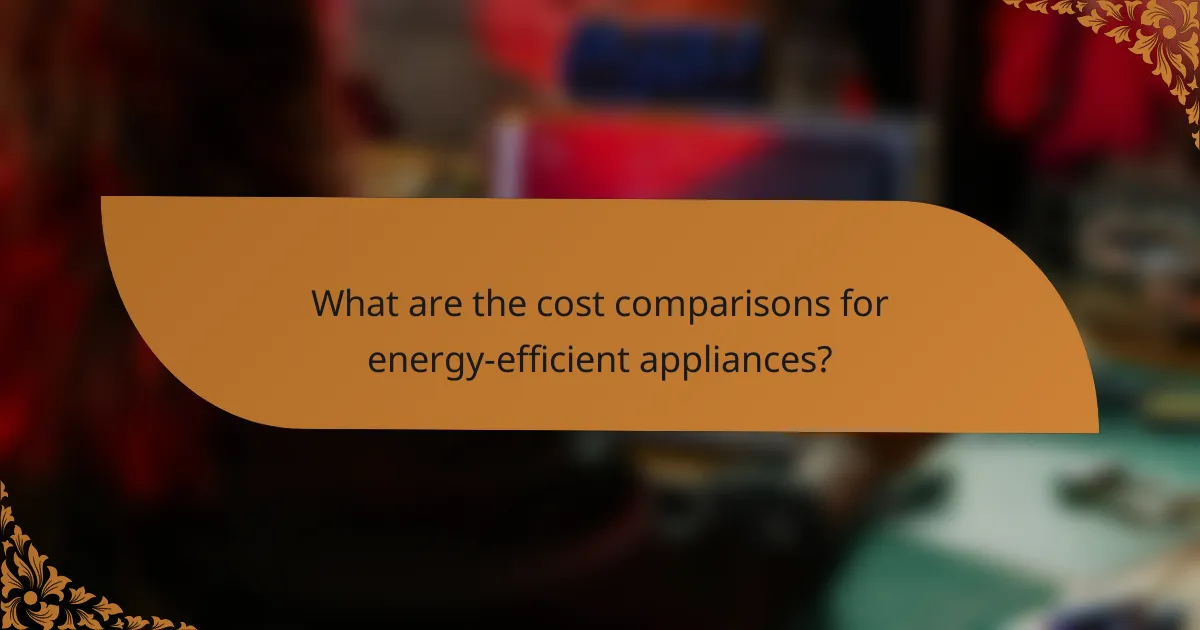
What are the cost comparisons for energy-efficient appliances?
Energy-efficient appliances often have higher upfront costs but can lead to significant savings over time. Understanding the cost comparisons involves evaluating initial purchase prices, long-term utility savings, and available incentives.
Initial purchase costs
The initial purchase costs for energy-efficient appliances can vary widely based on the type and brand. Typically, these appliances may cost anywhere from 10% to 50% more than their standard counterparts. For example, an energy-efficient refrigerator might range from $1,000 to $2,500, while a traditional model could be found for $800 to $1,500.
When considering initial costs, it’s essential to factor in the appliance’s efficiency rating, as higher-rated models may offer better performance and lower energy consumption, justifying the higher price tag.
Long-term savings on utility bills
Long-term savings on utility bills can be substantial with energy-efficient appliances. These appliances typically consume less electricity or water, leading to monthly savings that can add up over time. For instance, a high-efficiency washing machine can save a household around $50 to $100 annually on water and energy costs.
Over the lifespan of an appliance, which can be 10 years or more, these savings may total several hundred to thousands of dollars, making energy-efficient options a financially sound choice in the long run.
Incentives and rebates available
Many governments and utility companies offer incentives and rebates to encourage the purchase of energy-efficient appliances. These can range from direct cash rebates to tax credits, often covering 10% to 30% of the appliance’s cost. For example, some states in the U.S. provide rebates for Energy Star-rated appliances, which can significantly reduce the initial financial burden.
Before purchasing, check local regulations and available programs, as these incentives can vary by location and may change over time. Utilizing these rebates can enhance the overall affordability of energy-efficient appliances.
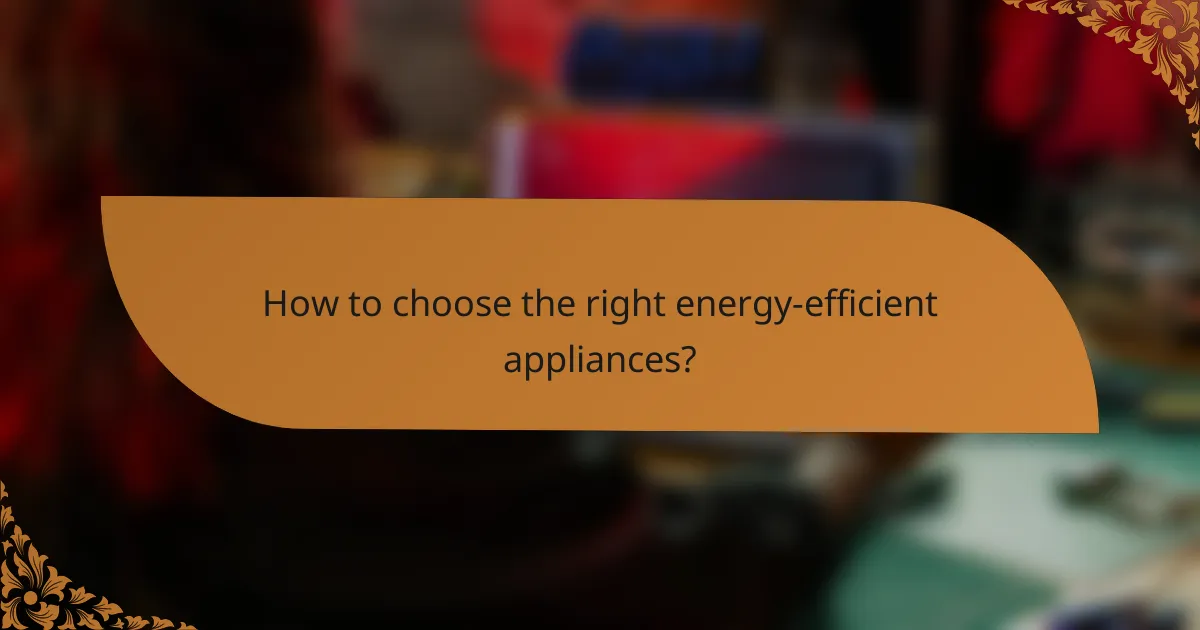
How to choose the right energy-efficient appliances?
Choosing the right energy-efficient appliances involves understanding their energy ratings, features, and any local utility incentives that may apply. Prioritize appliances that not only save energy but also fit your specific needs and budget.
Assessing energy ratings
Energy ratings indicate how efficiently an appliance uses energy, often represented by labels such as ENERGY STAR in the U.S. or A+++ in Europe. Look for appliances with higher ratings, as they typically consume less electricity, leading to lower utility bills.
When comparing appliances, consider the estimated annual energy consumption, usually expressed in kilowatt-hours (kWh). For example, an appliance that uses 300 kWh per year may save you significantly compared to one that uses 600 kWh, especially over time.
Evaluating appliance features
Features can greatly impact an appliance’s efficiency and usability. Look for options like smart technology that allows for remote monitoring and control, which can help optimize energy use. Additionally, consider features that enhance performance, such as variable speed motors in refrigerators or programmable settings in washing machines.
Assess the size and capacity of the appliance as well. A larger appliance may seem more efficient, but if it exceeds your needs, it could lead to wasted energy. Choose sizes that match your household requirements for the best efficiency.
Considering local utility incentives
Many local utilities offer incentives for purchasing energy-efficient appliances, such as rebates or tax credits. Research your local utility programs to see what financial benefits are available, which can significantly reduce the upfront cost of these appliances.
Incentives can vary widely by region, so check with your utility provider or visit their website for specific details. Some programs may require pre-approval or specific models to qualify, so be sure to review the requirements carefully before making a purchase.
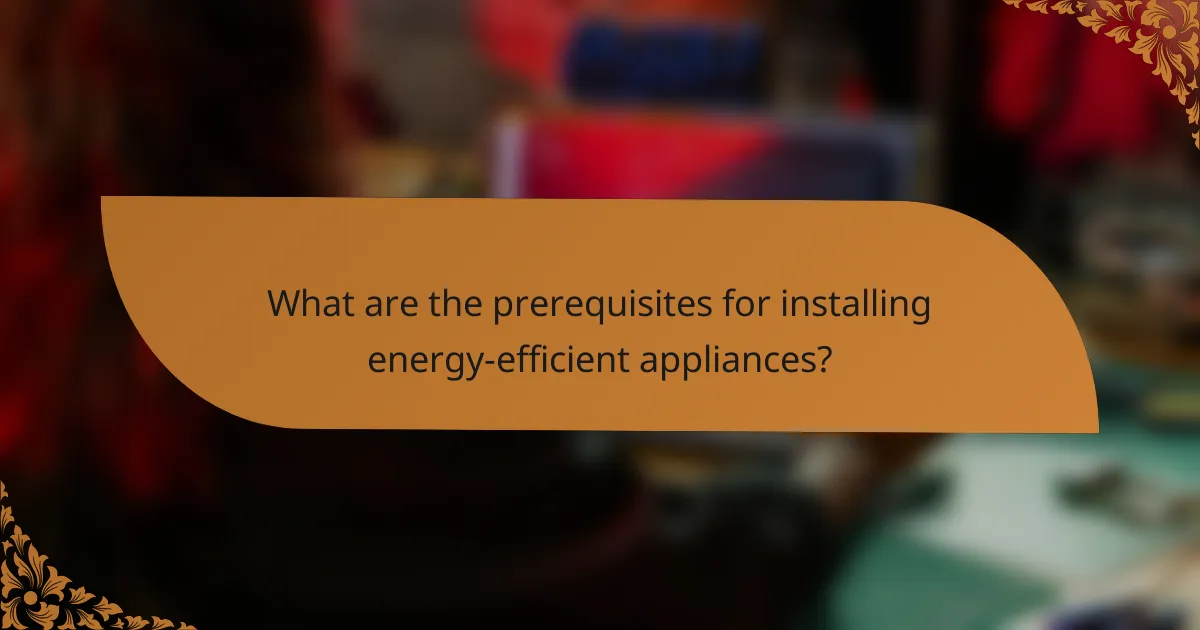
What are the prerequisites for installing energy-efficient appliances?
Before installing energy-efficient appliances, homeowners should assess their current energy systems and infrastructure to ensure compatibility and optimal performance. Key prerequisites include conducting a home energy audit, evaluating the electrical system, and considering the available space and layout for new appliances.
Home energy audit requirements
A home energy audit is essential for identifying areas where energy is wasted and determining the best energy-efficient appliances for your home. This audit typically involves a thorough inspection of insulation, windows, and existing appliances, often performed by a certified energy auditor. Homeowners can expect to pay between $200 and $600 for a professional audit, depending on the size of the home and the complexity of the assessment.
After the audit, homeowners receive a report detailing energy-saving recommendations, which can guide the selection of appliances that align with their energy goals. Implementing suggested changes can lead to significant long-term savings on utility bills.
Electrical system upgrades
Upgrading the electrical system may be necessary to support new energy-efficient appliances, especially if they require higher voltage or amperage. Homeowners should consult with a licensed electrician to evaluate the existing electrical capacity and determine if upgrades are needed. Typical upgrades might include installing new circuits or enhancing the main electrical panel.
Costs for electrical upgrades can vary widely, ranging from a few hundred to several thousand dollars, depending on the extent of the work required. Ensuring the electrical system is up to code is crucial for safety and efficiency.
Space and layout considerations
When installing energy-efficient appliances, it’s important to consider the available space and layout in your home. Measure the dimensions of the area where the appliance will be placed to ensure a proper fit, and account for ventilation and access for maintenance. Some energy-efficient models may have specific installation requirements that could affect placement.
Additionally, consider how the new appliances will integrate with existing kitchen or laundry room layouts. Planning for adequate space can prevent costly adjustments later and enhance the overall functionality of the area.
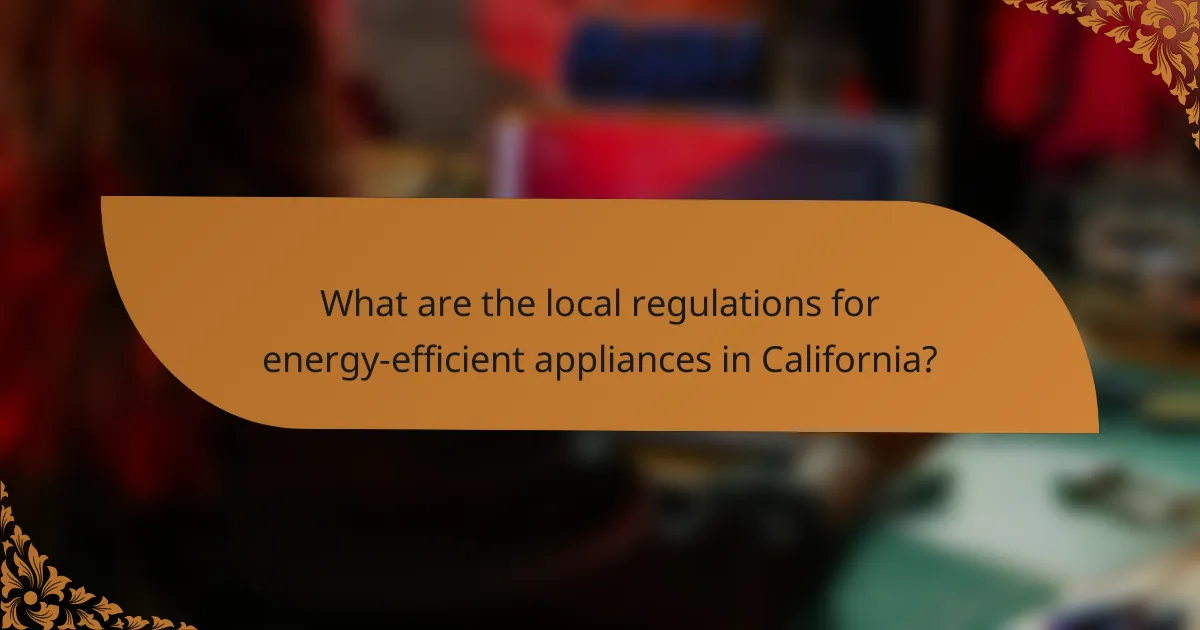
What are the local regulations for energy-efficient appliances in California?
California has strict regulations for energy-efficient appliances aimed at reducing energy consumption and greenhouse gas emissions. The state mandates compliance with the California Energy Commission (CEC) standards, which include efficiency requirements for various appliances and equipment.
Energy Star Certification
Appliances that meet the Energy Star certification are recognized for their superior energy efficiency. In California, many appliances must meet or exceed these standards to be sold or installed. This includes refrigerators, dishwashers, and washing machines, which must consume less energy than their non-certified counterparts.
Title 20 Appliance Standards
Title 20 of the California Code of Regulations sets specific energy efficiency standards for appliances sold in the state. These standards cover a wide range of products, including lighting, heating, and cooling systems. Compliance with Title 20 is mandatory for manufacturers and retailers, ensuring that only energy-efficient models are available to consumers.
Incentives and Rebates
California offers various incentives and rebates for homeowners who purchase energy-efficient appliances. Programs like the Energy Upgrade California initiative provide financial assistance to encourage the adoption of energy-saving technologies. Homeowners can often receive rebates that offset the initial costs of purchasing qualifying appliances.
